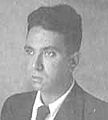René Iché facts for kids
Quick facts for kids
René Iché
|
|
|---|---|

René Iché
|
|
| Born | 21 January 1897 Sallèles-d'Aude, France
|
| Died | 23 December 1954 (aged 57) Paris, France
|
| Nationality | French |
| Known for | Sculpture |
|
Notable work
|
The Torn, Guernica |
| Movement | Modern art, surrealism |
| Awards | Grand prix de Sculpture |
René Iché (born January 21, 1897 – died December 23, 1954) was a famous French sculptor. He lived and worked in the 20th century. Iché is known for his powerful and emotional sculptures.
Contents
Who Was René Iché?
René Iché was born in a town called Sallèles-d'Aude, in France. He bravely served in World War I and was injured during his time there. After the war, he first studied law. However, he soon decided to follow his passion for art.
Becoming a Sculptor
Iché chose to study sculpture with a famous artist named Antoine Bourdelle. He also learned about architecture from Auguste Perret. In 1927, his peaceful monument in Ouveillan was very well received. This showed his talent early on.
His first art show was in 1931. Two of his sculptures were bought by important museums. One went to the Musée National d'Art Moderne in Paris. The other went to the Museum Boijmans Van Beuningen in Rotterdam.
Family Life
In 1928, René Iché married his model, Rosa Achard. She was also known as Renée. Their daughter, Laurence Iché, later became a writer. She even posed for some of her father's sculptures.
Iché's Art and Friends
René Iché had many famous friends in the art world. He was very close to Max Jacob. He also knew Guillaume Apollinaire, Pablo Picasso, Jacques Lipchitz, and Ossip Zadkine. He sculpted the faces of important writers like André Breton, Paul Éluard, and Federico García Lorca.
The Guernica Sculpture
In 1937, a terrible event happened in the Spanish town of Guernica. On the very day the news was announced, René Iché created a sculpture called Guernica. He made it in his studio in Montparnasse, Paris. Even though it was a powerful piece, he chose not to show it publicly.
Art and Resistance
During World War II, Iché was one of the first 200 people to join the French Resistance. This was a secret group fighting against the occupation of France. He was part of the Groupe du musée de l'Homme. He also took part in exhibitions that showed art that was considered "degenerate" by the occupiers.
He created a sculpture called La Déchirée, which means The Torn. This sculpture was sent to London and given to General Charles de Gaulle. It became a powerful symbol of the French Resistance.
Later Achievements and Legacy
René Iché continued to create important art. In 1948, he showed his sculpture Le Couple at the Venice Biennale. This is a very famous art exhibition. In 1953, he won the Grand Prix de Sculpture for his work Melpomène 36.
His art was even part of the art competition at the 1948 Summer Olympics. He was chosen for two big projects: a monument for Guillaume Apollinaire in Paris and a memorial for Auschwitz in Poland. Sadly, he passed away before he could finish them.
Iché's art style is often linked to surrealism. This art movement explores dreams and the imagination. His work shares similarities with other sculptors like Alberto Giacometti and Germaine Richier. They all learned from Antoine Bourdelle.
René Iché once said, "On the manure of the Millennia after geological cataclysms and warlike disasters, only the statues will remain." This shows how much he believed in the lasting power of sculpture.
René Iché in Film
The movie Army of Shadows (1969) by Jean-Pierre Melville is based on a book by Joseph Kessel. The story is about the Resistance network that René Iché was part of. The character Luc Jardie in the film is inspired by Iché.
Images for kids
See also
 In Spanish: René Iché para niños
In Spanish: René Iché para niños




